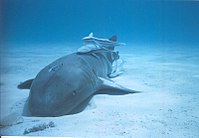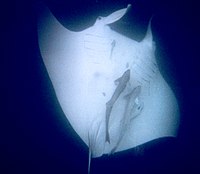Remora
| Remora | |
|---|---|

| |
| Spearfish remora, Remora brachyptera | |
| Scientific classification | |
| Kingdom: | |
| Phylum: | |
| Class: | |
| Order: | |
| Suborder: | |
| Superfamily: | |
| Family: | Echeneidae
|
| Genera | |
|
Echeneis | |
| Synonyms | |
|
Echeneididae | |
A remora (/[invalid input: 'icon']ˈrɛmərə/), sometimes called a suckerfish or sharksucker, is an elongated, brown fish in the order Perciformes and family Echeneidae.[1][2][3] They grow to 30–90 centimetres long (1–3 ft), and their distinctive first dorsal fin takes the form of a modified oval sucker-like organ with slat-like structures that open and close to create suction and take a firm hold against the skin of larger marine animals. By sliding backward, the remora can increase the suction, or it can release itself by swimming forward. Remoras sometimes attach to small boats. They swim well on their own, with a sinuous, or curved, motion.
Remoras are primarily tropical open-ocean dwellers, occasionally found in temperate or coastal waters if they have attached to large fish that have wandered into these areas. In the mid-Atlantic, spawning usually takes place in June and July; in the Mediterranean, in August and September. The sucking disc begins to show when the young fish are about 1 centimetre long. When the remora reaches about 3 centimetres, the disc is fully formed and the remora is then able to hitch a ride. The remora's lower jaw projects beyond the upper, and there is no swim bladder.
Some remoras associate primarily with specific host species. Remoras are commonly found attached to sharks, manta rays, whales, turtles and dugong (hence the common names 'sharksucker' and 'whalesucker'). Smaller remoras also fasten onto fish like tuna and swordfish, and some small remoras travel in the mouths or gills of large manta rays, ocean sunfish, swordfish and sailfish.
The relationship between remoras and their perfect hosts is most often taken to be one of commensalism, specifically phoresy. The host they attach to for transport gains nothing from the relationship, but also loses little. The remora benefits by using the host as transport and protection and also feeds on materials dropped by the host. There is controversy whether a remora's diet is primarily leftover fragments, or the feces of the host. In some species (Echeneis naucrates and E. neucratoides) consumption of host feces is strongly indicated in gut dissections.[4] For other species, such as those found in a host's mouth, scavenging of leftovers is more likely. For some remora and host pairings the relationship is closer to mutualism, with the remora cleaning bacteria and other parasites from the host. [citation needed]
Species

There are eight species in four genera:
- Genus Echeneis
- Live sharksucker, Echeneis naucrates Linnaeus, 1758.
- Whitefin sharksucker, Echeneis neucratoides Zuiew, 1786.
- Genus Phtheirichthys
- Slender suckerfish, Phtheirichthys lineatus (Menzies, 1791).
- Genus Remora
- Whalesucker, Remora australis (Bennett, 1840).
- Spearfish remora, Remora brachyptera (Lowe, 1839).
- Marlin sucker, Remora osteochir (Cuvier, 1829).
- Common remora, Remora remora (Linnaeus, 1758).
- Genus Remorina
- White suckerfish, Remorina albescens (Temminck & Schlegel, 1850).
Use for fishing
Some cultures use remoras to catch turtles. A cord or rope is fastened to the remora's tail, and when a turtle is sighted the fish is released from the boat; it usually heads directly for the turtle and fastens itself to the turtle's shell, and then both remora and turtle are hauled in. Smaller turtles can be pulled completely into the boat by this method, while larger ones are hauled within harpooning range. This practice has been reported throughout the Indian Ocean, especially from eastern Africa near Zanzibar and Mozambique,[5] and from northern Australia near Cape York and Torres Strait.[6][7]
Similar reports come from Japan and from the Americas. Some of the first records of the "fishing fish" in the Western literature come from the accounts of the second voyage of Christopher Columbus. However, Leo Wiener considers the Columbus accounts to be apocryphal: what was taken for accounts of the Americas may have in fact been notes that Columbus derived from accounts of the East Indies, his desired destination.[8]
Mythology
In ancient times, the remora was believed to stop a ship from sailing. In Latin, remora means "delay," while the genus name Echeneis comes from Greek echein ("to hold") and naus ("a ship"). There is a notable account by Pliny the Younger, in which the remora is blamed for the defeat of Mark Antony at the Battle of Actium and (indirectly) for the death of Caligula.[9] A modern version of the story is given by Jorge Luis Borges in Book of Imaginary Beings (1957).
Because of the shape of the jaws, appearance of the sucker and coloration of the remora, it sometimes appears to be swimming upside down. This probably led to the older common name reversus, although this might also derive from the fact that the remora frequently attaches itself to the tops of manta rays or other fish, so that the remora is upside down while attached.
-
Remora shows its sucker-like organ
-
Nurse shark with remoras attending
-
Manta ray with remoras
See also
- Lampreys, a blood sucking fish
- List of fish families
References
- ^ "Shark sucker". Gulf of Maine Research Institute. Retrieved 9 November 2009.
- ^ Froese, Rainer; Pauly, Daniel (eds.). "Family Echeneidae". FishBase. January 2006 version.
- ^ "Echeneidae". Integrated Taxonomic Information System. Retrieved 20 March 2006.
- ^ E. H. Willams; et al. (2003). "Echeneid-sirenian associations, with information on sharksucker diet". Journal of Fish Biology. 63 (5): 1176–1183. doi:10.1046/j.1095-8649.2003.00236.x.
{{cite journal}}: Explicit use of et al. in:|author=(help) - ^ E. W. Gudger (1919). "On the Use of the Sucking-Fish for Catching Fish and Turtles: Studies in Echeneis or Remora, II., Part 1". The American Naturalist. 53 (627): 289–311. doi:10.1086/279716. JSTOR 2455925.
- ^ E. W. Gudger (1919). "On the Use of the Sucking-Fish for Catching Fish and Turtles: Studies in Echeneis or Remora, II., Part 2". The American Naturalist. 53 (628): 446–467. doi:10.1086/279724. JSTOR 2456185.
- ^
- Narrative of the Voyage of H.M.S. Rattlesnake at Project Gutenberg (Dr. Gudger's accounts are more authoritative, but this source is noted as an early account that Gudger appears to have missed.)
- ^ Leo Wiener (1921). "Once more the sucking-fish". The American Naturalist. 55 (637): 165–174. doi:10.1086/279802. JSTOR 2456418.
- ^ Pliny the Elder. "Book 32, Chapter 1". Natural History. (cited in E. W. Gudger (1930). "Some old time figures of the shipholder, Echeneis or Remora, holding the ship". Isis. 13 (2): 340–352. doi:10.1086/346461. JSTOR 224651.)
External links
- Photos tagged with "remora" at Flickr
- National Aquarium Article About Remoras
- Youtube video of sharks with numerous Remoras




